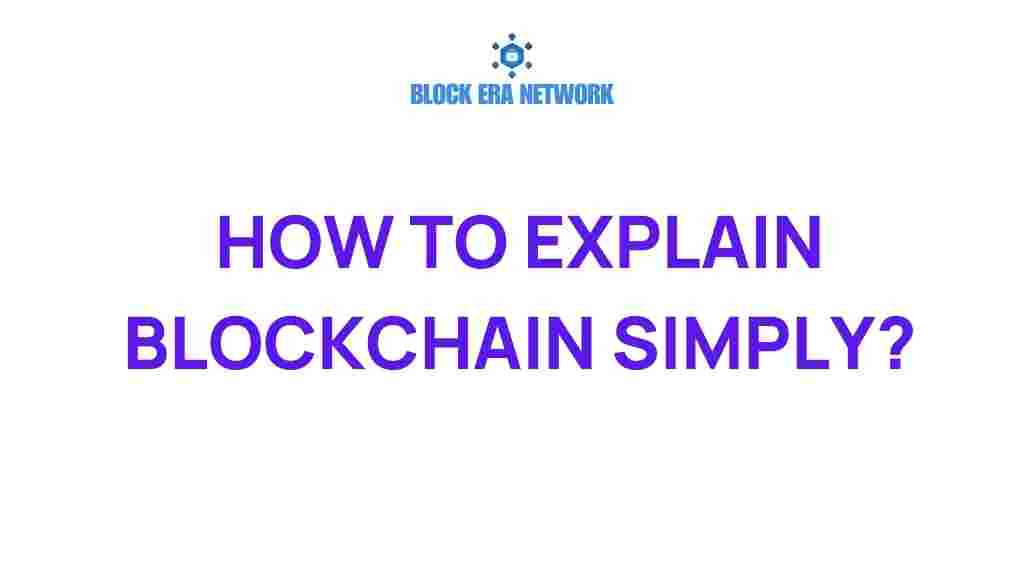Unlocking the Mysteries of Blockchain: A Simple Guide
Blockchain technology has emerged as one of the most revolutionary innovations of the 21st century. At its core, it is a digital ledger that records transactions in a secure, transparent, and decentralized manner. This article aims to provide a comprehensive explanation of blockchain, exploring its significance in the world of cryptocurrency and beyond, while also shedding light on its future potential.
What is Blockchain Technology?
Blockchain is a decentralized database that maintains a continuously growing list of records called blocks. Each block contains a number of transactions, and once a block is filled, it is linked to the previous block, forming a chain—hence the name “blockchain.” This structure provides several key benefits:
- Decentralization: Unlike traditional ledgers that are controlled by a central authority, blockchain operates on a network of computers (nodes), making it resistant to manipulation and fraud.
- Security: Blockchain employs cryptographic techniques to secure data, ensuring that once information is added to the ledger, it cannot be altered without consensus from the network.
- Transparency: All transactions on a blockchain are visible to all participants, promoting accountability and trust among users.
The Role of Blockchain in Cryptocurrency
Blockchain technology is the backbone of cryptocurrencies like Bitcoin and Ethereum. Here’s how it fits into the cryptocurrency landscape:
- Transaction Validation: When a user initiates a transaction, it is broadcasted to the network, where it is validated by miners through complex algorithms.
- Mining: This process involves solving cryptographic puzzles to add new blocks to the blockchain, rewarding miners with cryptocurrency.
- Peer-to-Peer Transactions: Blockchain enables direct transactions between users without needing intermediaries like banks, reducing fees and processing times.
The Benefits of Blockchain Technology
Blockchain technology offers several advantages that extend beyond cryptocurrency:
- Enhanced Security: The combination of encryption and decentralization makes blockchain highly secure against cyberattacks.
- Improved Efficiency: By eliminating intermediaries and streamlining processes, blockchain can significantly reduce transaction times and costs.
- Greater Transparency: All participants have access to the same information, which reduces the potential for disputes and enhances trust.
How Blockchain Works: A Step-by-Step Explanation
Understanding how blockchain works is crucial for appreciating its impact. Here’s a breakdown of the process:
Step 1: Transaction Initiation
A user initiates a transaction, such as sending cryptocurrency to another user. This transaction is then broadcasted to the network.
Step 2: Transaction Verification
Network nodes validate the transaction using cryptographic algorithms. This ensures that the sender has enough balance and that the transaction is legitimate.
Step 3: Block Creation
Once verified, the transaction is grouped with other transactions into a new block. Each block contains a unique code (hash) and the hash of the previous block, linking them together.
Step 4: Consensus Mechanism
The new block is then added to the blockchain through a consensus mechanism. The most common mechanisms are Proof of Work (PoW) and Proof of Stake (PoS).
Step 5: Completion of Transaction
After the block is added, the transaction is considered complete, and the updated ledger is distributed across the network.
Common Misconceptions About Blockchain
Despite its growing popularity, many misconceptions surround blockchain technology. Here are a few:
- Blockchain is synonymous with Bitcoin: While Bitcoin uses blockchain, the technology has applications beyond cryptocurrency, including supply chain management, healthcare, and finance.
- Blockchain is entirely anonymous: While transactions can be pseudonymous, the transparency of blockchain means that transactions can be traced back to their origins.
- Blockchain is infallible: Although blockchain is secure, it is not immune to risks, such as the potential for human errors or bugs in the code.
Challenges and Limitations of Blockchain Technology
While blockchain technology presents numerous advantages, it also faces several challenges:
- Scalability: As the number of users and transactions grows, maintaining speed and efficiency can become challenging.
- Energy Consumption: Certain consensus mechanisms, like PoW, require significant energy, raising concerns over environmental impact.
- Regulatory Concerns: The decentralized nature of blockchain poses challenges for regulation and legal frameworks, which are still evolving.
The Future of Blockchain Technology
The future of blockchain technology looks promising, with potential advancements in various sectors:
- Financial Services: Blockchain could revolutionize banking by enabling faster and cheaper cross-border transactions.
- Supply Chain Management: Companies can use blockchain to track products from origin to consumer, enhancing transparency and reducing fraud.
- Healthcare: Patient records could be securely stored on a blockchain, giving patients more control over their data.
Getting Started with Blockchain
If you’re interested in exploring blockchain technology further, here are some steps to get started:
- Educate Yourself: Read books, attend webinars, and follow reputable blogs to understand the fundamentals of blockchain.
- Experiment: Consider trying out blockchain platforms like Ethereum or Hyperledger to gain hands-on experience.
- Join Communities: Engage with online and local blockchain communities to learn from others and share your insights.
Troubleshooting Common Issues
When dealing with blockchain technology, you may encounter some common issues. Here are some troubleshooting tips:
- Transaction Not Confirmed: If your transaction is taking longer than expected, check the network congestion or consider increasing the transaction fee.
- Lost Access to Wallet: Always keep a backup of your wallet’s private keys and recovery phrases to prevent loss of funds.
- Security Breaches: Ensure you are using secure wallets and two-factor authentication to protect your assets.
Conclusion
Blockchain technology is at the forefront of digital innovation, offering solutions for security, transparency, and decentralization. As more industries begin to recognize its potential, the future of blockchain seems bright. Whether you’re a tech enthusiast, a business leader, or simply curious about cryptocurrency, understanding blockchain is essential in today’s digital landscape. For more insights and detailed information about blockchain, explore resources like CoinDesk and join the conversation!
In summary, embracing blockchain technology can pave the way for a more secure and transparent future, transforming how we conduct transactions and manage data.
This article is in the category Blockchain Basics and created by Block Era Network Team
